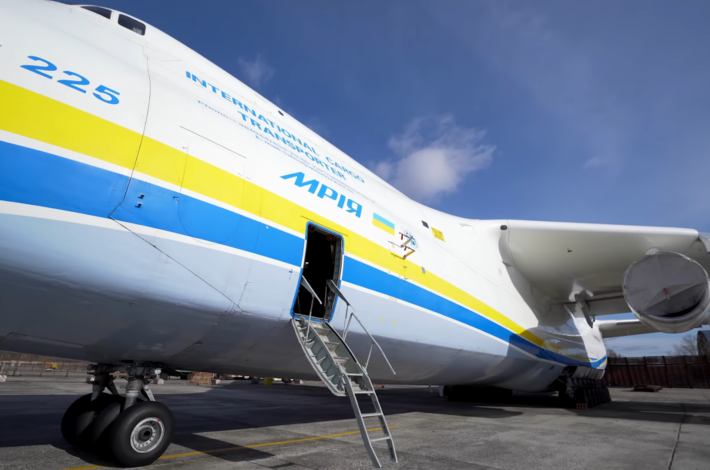
The Antonov AN-225 Mriya, a legendary aircraft originating from Ukraine, occupies a truly exceptional position in the annals of aviation. Notably, its inaugural flight signified a groundbreaking moment, as it emerged as the largest aircraft ever manufactured. While certain planes may boast wider wingspans, the AN-225 Mriya undeniably holds the esteemed distinction of being the largest aircraft, owing to its immense dimensions, impressive maximum takeoff weight (MTOW) of 640 tons, and extraordinary payload capacity of 250 tons. Appropriately named “Mriya,” which translates to “dream” in Ukrainian, this aircraft has effortlessly captivated aviation enthusiasts worldwide with its awe-inspiring presence.
Taking flight for the first time on December 21, 1988, the AN-225 Mriya was specifically engineered to transport the Buran shuttle orbiter and components of the Energiya carrier rocket. It drew inspiration from the design of its smaller sibling, the AN-124. The construction of the fuselage and tail unit was carried out at the Antonov Kyiv facilities, while the wing panels, crafted in Tashkent, Uzbekistan, were transported to the Ukrainian capital via AN-22 aircraft. It is worth mentioning that the AN-22, equipped with four contra-rotating propellers, retains the remarkable distinction of being the largest turboprop plane ever constructed.
Following Ukraine’s declaration of independence in 1991, the AN-225 Mriya underwent a period of inactivity from 1994 to 2001. However, in 2001, Antonov completed an extensive overhaul of the aircraft, coinciding with the acquisition of the AN-225 Type Certificate. In the subsequent years, the Mriya joined the esteemed fleet of Antonov Airlines, a specialized charter airline facilitating the transportation of oversized and heavy cargo to various destinations across the globe.
It is truly remarkable that only one AN-225 was manufactured by Antonov, accompanied by an unfinished aircraft that solely possessed the fuselage. However, a tragic turn of events unfolded during the invasion of Ukraine by Russia, resulting in the destruction of the remarkable AN-225 Mriya bearing the registration UR-82060. This devastating incident took place at Antonov Airport in Hostomel, near Kyiv. Since February 24, 2021, Ukraine has faced the relentless onslaught of the Russian invasion, profoundly impacting the lives of its people.
I vividly reminisce about my initial encounter with an Antonov aircraft, the AN-124, during an enthralling air show. Its colossal size left me pondering over the monumental dimensions of the AN-225 Mriya. When the AN-225 arrived in Kyiv for a commemorative show marking Ukraine’s 30th anniversary of independence, I was fortunate enough to witness its magnificence up close. The majestic wings gracefully stretched out, seemingly waving to the mesmerized spectators. No words can adequately convey the overwhelming spectacle it presented. Having seen the likes of Airbus A380, Airbus Beluga, and Boeing 747, I can confidently declare that none of them can rival the sheer magnitude displayed by the AN-225 as it soars through the sky.
The aviation community sorely misses the Antonov AN-225, leading many to ponder if a second aircraft will ever be built. Ukraine possesses the engineering expertise necessary for completing another AN-225. The legacy of Ukrainian aviation pioneers, including Igor Sikorsky, the developer of the Sikorsky helicopter, as well as companies like Antonov, Ivchenko-Progress, and Motor Sich, exemplify Ukraine’s aviation capabilities. I remain hopeful that the AN-225 Mriya will once again take flight.
The AN-225 Mriya received a well-deserved tribute from Ukrainian Post (Ukrposhta) in the form of a stamp featuring an illustration by 11-year-old Sofia.
Masterpiece of Design: Exploring the Antonov AN-225 Mriya
Derived from the AN-124, the AN-225 was meticulously crafted with careful modifications to accommodate its role in airlifting heavy loads, particularly the Buran shuttle. By extending the fuselage of the AN-124 with barrel extensions both forward and aft of the wing, an impressive cargo compartment measuring 141 feet in length was created. To enhance fuel efficiency, reduce drag, and increase range, the rear ramp was eliminated while maintaining the cross-section of the cargo hold. The AN-225 also boasted two small crew cabins, contributing to its immense total length of 84 meters. The cargo compartment itself measured 43.3 x 6.4 x 4.4 meters, providing ample space for substantial payloads.
To cater to its larger size, the AN-225 incorporated an extension of the AN-124’s wings. Antonov expanded the wing area by 30% utilizing the AN-124’s proven wing design with minimal modifications. This expansion facilitated the installation of two additional engines, bringing the total number of turbofans to six. Consequently, the wingspan of the AN-225 was extended, resulting in an impressive span of 88.4 meters. Notably, the AN-225 Mriya sported a distinctive high-wing anhedral design.
Considering its primary purpose of transporting the Buran, the AN-225 underwent tail modifications to ensure undisturbed airflow beyond the tail. To address this requirement, the AN-225 transitioned from a single vertical stabilizer to a twin tail configuration, featuring an expanded and swept-back horizontal stabilizer. This alteration allowed the aircraft to carry heavy external loads without disrupting airflow around a conventional tail design.
Incorporating quadruplex fly-by-wire technology, the AN-225 employed a sophisticated system that combined four separate systems to ensure optimal reliability. The skilled crew of the aircraft comprised pilots, engineers, navigators, and radio operators. After undergoing refurbishment in 2001, the Antonov AN-225 was equipped with cutting-edge radio and navigation systems, enabling it to operate on both civil and commercial routes.
Designed to withstand challenging conditions, the AN-225 boasted robust landing gear. Each side of the aircraft featured ten primary landing gear units, each equipped with two wheels, resulting in a total of twenty wheels. Notably, the leading pair of units on each side had independent steering capabilities. Building upon the landing gear of the AN-124, the AN-225’s gear was an upgraded version featuring the addition of two tandem bogeys, effectively accommodating a total of 32 wheels to handle the increased weight and maintain stability during landing and takeoff.
Retaining the “kneeling” capability of the nose gear, the AN-225 facilitates the loading and unloading of cargo. Unlike the AN-124, the AN-225 has a single cargo door and ramp at the front, enabling cargo to be loaded through the front door and ramp. The nose cargo door hydraulically raises at the front. The AN-225’s pressurized cargo capability expands the range of goods that can be transported, and a built-in crane further facilitates operations.
The most recent overhaul of the AN-225 was completed in 2001, amounting to a cost of $20 million. Ukrainian aircraft engine company Motor-Sich contributed to the necessary funds to support Antonov, and this overhaul included reinforcements that raised the MTOW to 640,000 kg.
Antonov AN-225 Mriya Specs
| Measurement | Value |
|---|---|
| Length | 84 m |
| Height | 18.1 m |
| Wingspan | 88.4 m |
| Max. Payload | 250,000 kg |
| Max. Volume | 1,200 CBM |
| Cargo Cabin LWH | 43.3×6.4×4.4 m |
| Including Ramp | 45.4×6.4×4.4 m |
| Cargo Door WH | 6.4×4.4 m |
| On-Board Crane | 30,000 kg lift |
| Crew | 6 |
Performance Insights of the Antonov AN-225 Mriya
The Antonov AN-225 Mriya is equipped with an impressive array of six Ivchenko-Progress D-18T high-bypass, three-spool turbofan engines. These remarkable engines, meticulously designed by Ivchenko-Progress and manufactured by Motor-Sich, deliver an outstanding thrust rating of 51,500 lbf (229 kN). Ivchenko-Progress, a renowned governmental design agency, specializes in the development of aviation engines, while Motor-Sich stands as a prominent global engine manufacturer.
With the combined power of its six engines, the AN-225 Mriya can generate a total thrust of 309,000 lbf, enabling the aircraft to take off at a maximum weight of 640,000 kilograms (1,410,958 lbs). The AN-225 possesses a substantial fuel capacity of 35 tons, distributed among its 13 integrated wing tanks. For auxiliary power, the aircraft relies on Aerosila TA12 turboshaft engines, providing a maximum power output of 287 kW.
Impressively, the AN-225 attains a maximum speed of 850 kilometers per hour, with its cruising speed typically ranging around 800 kilometers per hour (M0.64) (M0.68). Designed primarily for longer runways, the AN-225 necessitates a minimum runway length of 3,500 meters for its operations. However, depending on the takeoff weight, it is capable of executing takeoffs from distances as short as 2,650 meters.
The AN-225 Mriya demonstrates an extraordinary ferrying distance of 15,400 kilometers (8,315.33 nm). However, when loaded with a cargo weighing 200 tons, the range is reduced to approximately 4,500 kilometers (2,430 nm). The aircraft proudly boasts an exceptional payload capacity of up to 250 tons, showcasing its immense capability in transporting heavy loads. With an operational ceiling of 9,000 meters (29,500 ft), the AN-225 Mriya confidently operates at high altitudes.
Antonov Airlines
Antonov Airlines, founded in 1989, emerged as a leading player in the realm of international air transportation of large and heavy cargo. Recognizing the escalating demand for such services, the company strategically built a fleet comprising seven AN-124 aircraft, securing exclusive rights to operate the AN-225 and AN-22. This positioned Antonov Airlines as a formidable force, specializing in the transportation of colossal and weighty loads. As true pioneers in the aviation industry, they played a pivotal role in making the AN-124 available for commercial aviation, shaping the landscape of heavy cargo transportation.
In the late 1990s, Antonov Airlines swiftly attained remarkable and sustained success in the flourishing global market for large-scale freight transport. An important milestone in their journey was the decision to refurbish the sole existing AN-225, originally constructed in 1998. Following a comprehensive and substantial $20 million refurbishment, the AN-225 Mriya was reintroduced into service, ready to tackle formidable challenges. Throughout its operational tenure, the AN-225 set an impressive 242 records worldwide, firmly establishing itself as an icon of aviation prowess. Notably, the AN-225 played a crucial role in transporting vital medical supplies during the challenging times of the Coronavirus Pandemic. In the year 2020 alone, the AN-225 gallantly facilitated the transportation of over 1,300 tonnes of medical and humanitarian goods, leaving a profound impact on global relief efforts.
However, tragedy struck on February 24, 2022, when Antonov Airlines’ base came under attack from Russia. In a heartbreaking turn of events, the unique AN-225 with the registration UR-82060 met its untimely destruction. The AN-225 Mriya’s final journey occurred on February 5, as it embarked on a flight from Denmark to Ukraine before returning to its base. Carrying goods for approximately 8.5 hours during its flight from Manas, Kyrgyzstan, to Billund, Denmark, the aircraft fell victim to the brutal attack, enduring severe damage. It was not the sole casualty, as an AN-124 and an AN-22 also suffered significant harm.
In response to this devastating situation, several Antonov Airlines AN-124-100 aircraft have been relocated to Leipzig/Halle Airport in Germany. Despite the tremendous loss, these aircraft continue to serve a critical purpose by engaging in charter flights, primarily focused on providing essential humanitarian aid to the people of Ukraine. In the face of adversity, Antonov Airlines remains resilient, demonstrating their unwavering commitment to supporting those in need and contributing to the relief efforts in their homeland.
A Comparative Analysis Among Aircraft of Its Class
| Measurement | Antonov AN-225 | Airbus A380 | Boeing 747-8 | Lockheed C-5M Galaxy | Stratolaunch |
|---|---|---|---|---|---|
| Length | 84 m | 72.7 m | 76.3 m | 75.3 m | 73 m |
| Height | 18.1 m | 24.1 m | 19.4 m | 19.84 m | 15 m |
| Wingspan | 88.4 m | 79.8 m | 68.4 m | 67.89 m | 117 m |
| MTOW | 650 tons | 560 tons | 448 tons | 381 tons | 590 tons |
| Engines | 6 | 4 | 4 | 4 | 6 |
Conclusion
The Antonov AN-225 Mriya is a unique piece of aviation engineering, allowing for long-distance flights thanks to its amazing fuel capacity and carrying huge cargo thanks to its enormous size. The AN-225 is well-suited for long-distance missions with a range of 15,400 kilometers and a fuel capacity of 35 tons. This fuel economy, together with the AN-225’s enormous freight capacity of up to 250 tons, maintains its status as a real avian behemoth. As a testament to its capabilities, the AN-225 Mriya continues to captivate aviation enthusiasts and serve as a symbol of Ukrainian engineering prowess.
FAQ
Absolutely! The AN-225 is proudly a Ukrainian aircraft, meticulously produced by the esteemed company Antonov, headquartered in Kyiv.
“Mriya” holds a special place in the Ukrainian language, as it translates to “dream.” The AN-225 carries this beautiful name, representing the visionary aspirations and remarkable achievements it embodies.
Presently, there is only a singular AN-225 aircraft in existence. However, it is important to note that a second AN-225, which had its fuselage manufactured but remains unfinished, is planned for completion in the future.
Sadly, during the invasion of Ukraine, the only Antonov AN-225 met its unfortunate fate. The aircraft was destroyed near Gostomel/Antonov Airport, leaving a void in the aviation world.
When it comes to size, the Antonov AN-225 surpasses the C5 Galaxy. It proudly holds the distinction of being the largest aircraft ever constructed, showcasing its remarkable magnitude and capabilities.

